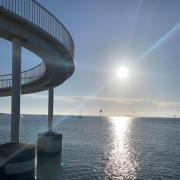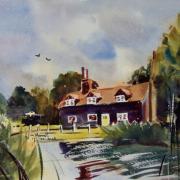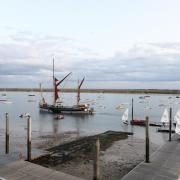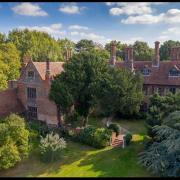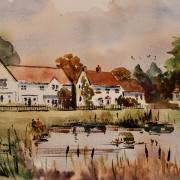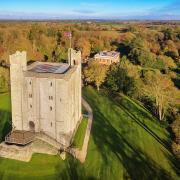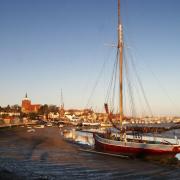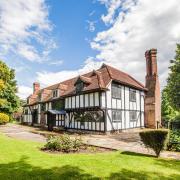Tilbury Fort, which sometimes goes by the name of the Thermitage Bulwark or West Tilbury Blockhouse is an old artillery fort located on the border of Essex with London on the north bank of the River Thames. Originally Tilbury Fort was constructed by the man who has so often graced these historical pages, none other than King Henry VIII.
The blockhouse that is Tilbury Fort was built to protect London from France as part of Henry’s device programme. Device Forts were built on the coastline between 1539 and 1547 when King Henry VIII decided to up the ante and defend himself against the constant threats from France and Spain. Previously the coastlines were the ruling Lord’s remits, but times changed and Henry was of the opinion that he needed to strengthen his coastal defences. As was often the case with Henry, these devices were hugely expensive and cost a whopping £367,000 in the sixteenth century, which would in today’s money have cost in the region of between £2 and £82 billion.
The device forts constructed were all paid for by the controversial Dissolution of the Monasteries when Henry collapsed all the Catholic priories and religious houses and sold off their land. Dumping his wife, Catherine of Aragon to marry the new woman of his choice, Anne Boleyn was the catalyst. Who could imagine that a divorce could have such repercussions in history? In 1533 Henry VIII broke with Rome and Charles V, the Holy Roman Emperor whose aunt was Catherine of Aragon took this as a personal affront. With the seal of approval from Pope Paul III, France attacked Henry for what he believed to be thoroughly poor choices. The rest, as they say, is history and this unrest between England, France and the Holy Roman Empire was what brought about the very construction of Tilbury Fort, the site of which today is a scheduled monument.

The River Thames, along with much of Southern England were strategically important for King Henry VIII amid all of this religious tension as this was the route of most of the English exports and extremely vulnerable to attacks. Henry commissioned the forts at Tilbury (and at the opposite side of the Thames at Gravesend in Kent) principally to protect access to London.
The fort was constructed at the narrow point (730 metres) that ferries would take people from one side to the other. One of the names for Tilbury Fort, Thermitage, hailed from the name of the Hermitage that Henry had dissolved in 1536. Initially, it was just a D-shaped blockhouse equipped with heavy guns and accommodation for its gunners whose job description was to sink enemy ships heading into London.
Tilbury Fort was decommissioned soon after in 1553 as the threats came to nothing. But this was not to be the end of it. When fresh tension arose in the shape of the Spanish Armada, Robert Dudley, the Earl of Leicester ordered emergency improvements to the fort. It was at Tilbury Fort that Queen Elizabeth I delivered her famous speech having arrived by barge. She was addressing the army when she said:
'I know I have the body of a weak and feeble woman;
but I have the heart and stomach of a king,
and of a king of England, too;
and think foul scorn that Parma or Spain,
or any prince of Europe,
should dare to invade the borders of my realms;
to which, rather than any dishonour should grow by me,
I myself will take up arms.'
Even after the defeat of the Spanish Armada, England still felt threatened. It was because of this threat that the help of the Italian architect, Frederico Genebelli was sought. English Heritage who manage Tilbury Fort describes it as 'one of the finest surviving examples of 17th-century military engineering in England.' After the Armada, a period of peace followed and Tilbury Fort was neglected. It was often flooded by the estuary tides and marauded by animals and ferry passengers.
During the 17th century, Tilbury Fort was occupied by the Parliamentary troops during the Civil War.

Charles I fell out with his parliamentarians and a veritable bloodbath ensued. Tilbury was controlled by the Parliamentarians who used both Tilbury and Gravesend forts to search for possible traitors and spies. Though Tilbury Fort played its own part during the Civil War no military action actually ever took place there, ironically Tilbury Forts’ defences were never tested by any enemy. In 1670 Tilbury Fort was given another upgrade under the supervision of de Gomme in the form of a pentagonal structure which is still visible to this day in light of the war with the Dutch. In the end, there are only four bastions as the fifth could not be constructed due to the marshy conditions that precluded it. In the 18th century when Britain was frequently at war, 8,500 barrels of gunpowder were stored at Tilbury Fort, more than anywhere else in Britain.
Tilbury Fort was also used to house prisoners during the Jacobite uprising in 1745. Conditions and executions of prisoners of War from the Highlands were bitter and often drawn at random. Tilbury Fort was garrisoned until the end of the Second World War and now serves as a tourist attraction. In the words of Paul Pattison, Senior Properties Historian for English Heritage, 'In 1950 the army finally left Tilbury Fort after 400 years.'






